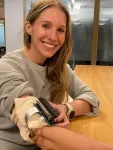(Press-News.org) BIRMINGHAM, Ala. – Over the course of life, memory fades with varying degrees, robbing older people of the ability to recollect personal experiences. This progressive, nearly inevitable process has long been hypothesized as a consequence of nature’s removal of dendritic spines, a key component of synapses, from brain neurons as they age.
A study published in Science Advances led by researchers at the University of Alabama at Birmingham and Rush University Medical Center, Chicago, Illinois, now provides evidence that the preservation of past life experiences is maintained by the quality — not the quantity — of synapses in old age.
“This is a paradigm breaker,” said Jeremy Herskowitz, Ph.D., associate professor in the UAB Department of Neurology and corresponding author of the study. “For 35 years, the predominant dogma was that memory decline is mediated predominantly by loss of dendritic spine, which are a surrogate for synapses. As we age from 40 through 85, there is natural loss of dendritic spines and synapses, which is completely normal. This natural loss can contribute to the lack of cognitive sharpness that we all feel as we age. However, we demonstrate that, even though there is synapse loss, the ones that are left can compensate for that loss.”
Herskowitz says this has an enormous implication. “Even in older individuals, people age 80, 90 or 95, there is still enough plasticity in synapse formation to retain memory. This means a therapy to remodel dendritic spines and synapses could dramatically facilitate memory as you age or if you are experiencing memory impairment due to Alzheimer’s disease dementia.”
The study was made possible by the Religious Orders Study and Rush Memory and Aging Project, or ROSMAP, at Rush University. ROSMAP enrolls Catholic nuns, priests and brothers age 65 or older, who are without known dementia at time of enrollment. Participants receive medical and psychological evaluations each year and agree to donate their brains after death.
Herskowitz and colleagues studied postmortem brain samples from 128 ROSMAP participants. The participants had an average age of 90.5 years at the time of death, with variable cognitive performance scores and Alzheimer’s disease-related neuropathology. They all had undergone yearly cognitive testing for episodic memory, visuospatial ability/perceptual orientation, perceptual speed, semantic memory, and working memory. The study included two samples from each brain, one from the temporal cortex, which has structures vital for long-term memory, and one from the frontal premotor cortex.
After staining the brain samples, photographing thin slices and building three-dimensional digital reconstructions of 55,521 individual dendritic spines on 2,157 neurons, researchers used two statistical methods, one employing innovative machine learning, to see if any of 16 different spine morphology measurements correlated with any of 17 different measures of brain function, age and Alzheimer’s disease neuropathology. One of the brain function measures was episodic memory — the ability to remember everyday events and past personal experiences.
For neurons from the temporal cortex, researchers found that dendritic spine head diameter, but not the quantity of spines, improved prediction of episodic memory in models containing β-amyloid plaque scores, neurofibrillary tangle pathology and sex. Larger head diameters were associated with better episodic memory performance, supporting the emerging hypothesis that, in the temporal cortex, synaptic strength is more critical than quantity for memory in old age.
“Targeting pathways that maintain spine head diameter or synaptic strength, rather than pathways that maintain or generate new spines or synapses, could potentially yield greater therapeutic benefits for older adults in preclinical phases of Alzheimer’s disease,” Herskowitz said.
A dendrite is a branched extension from a neuron body that receives impulses from other neurons. Each dendrite can have thousands of small protrusions called spines. The head of each spine can form a contact point called a synapse to receive an impulse sent from the axon of another neuron. Dendritic spines can rapidly change shape or volume while forming new synapses, part of the process called brain plasticity. Creating or eliminating synapses is a fundamental mechanism of brain function.
Collecting the tens of thousands of spine measurements took two and a half years. This painstaking work started in 2019 and continued through the COVID-19 pandemic, as UAB researchers worked under COVID restrictions, Herskowitz says.
Co-first authors of the study, “Dendritic spine head diameter predicts episodic memory performance in older adults,” are Courtney K. Walker and Evan Liu, UAB Department of Neurology.
Other authors are Kelsey M. Greathouse, Ashley B. Adamson, Julia P. Wilson, Emily H. Poovey, Kendall A. Curtis, Hamad M. Muhammad and Audrey J. Weber, UAB Department of Neurology; David A. Bennett, Rush University Medical Center; Nicholas T. Seyfried, Emory University School of Medicine; and Christopher Gaiteri, SUNY Upstate Medical University, Syracuse, New York.
Support came from National Institutes of Health grants NS061788, AG067635, AG061800, AG054719, AG063755, AG068024, AG10161, AG72975, AG15819, AG17917, AG46152 and AG61356.
At UAB, Neurology is a department in the Marnix E. Heersink School of Medicine.
END
Memory loss in aging and dementia: Dendritic spine head diameter predicts memory in old age
This finding suggests that therapy to remodel synapses could help memory in old age and dementia patients.
2024-08-07
ELSE PRESS RELEASES FROM THIS DATE:
Birmingham host to investigational treatment trial which could improve outcomes of pregnancies affected by severe haemolytic disease
2024-08-07
Pregnant mothers have taken part in a clinical study (the UNITY trial) in Birmingham, which has found that nipocalimab, an investigational, fully human, monoclonal antibody, has the potential to improve the survival rate of unborn babies with rare, early-onset fetal anaemia, as a result of haemolytic disease of the fetus and newborn (EOS-HDFN).
The study investigated pregnancies complicated by severe EOS-HDFN (RhD (D) or Kell (K) alloimmunized pregnant individuals with singleton pregnancies) and evaluated the effects of nipocalimab at weekly intervals from 14-35 ...
Drug trial for rare fetal blood disease shows promise for less invasive approach
2024-08-07
AUSTIN, Texas — Data from a new investigational drug that could alter the standard treatment for a rare blood disease suggests it has the potential to delay or prevent anemia and the need for intrauterine blood transfusions in babies who are at high risk for the condition, known as Hemolytic Disease of the Fetus and Newborn (HDFN). Results of the Phase 2 clinical trial of the drug nipocalimab were published today in The New England Journal of Medicine.
HDFN is a serious condition in which the blood types of the mother and her fetus do not match, potentially causing life-threatening anemia in the baby. The current ...
Forever chemical pollution can now be tracked
2024-08-07
Organofluorine compounds — sometimes called ‘forever chemicals’ — are increasingly turning up in our drinking water, oceans and even human blood, posing a potential threat to the environment and human health.
Now, researchers at The University of Texas at Austin have developed a way to fingerprint them, which could help authorities trace them to their source when they end up in aquifers, waterways or soil.
The technique involves passing samples through a strong magnetic field then reading the burst of radio waves their atoms emit. This reveals ...
How fungi elude antifungal treatments
2024-08-07
Every year, life-threating invasive fungal infections afflict more than 2 million individuals globally. Mortality rates for these infections are high, even when patients receive treatment.
Aspergillus fumigatus, the most frequent cause of invasive fungal infection in people with suppressed immune systems, is responsible for approximately 100,000 deaths annually around the world. Poor treatment outcomes result from therapeutic failures and the fungi’s resistance to existing drugs.
A new multi-institutional study led by researchers at Michigan State University has characterized how fungi adapt to restructure their cell walls, effectively ...
ACC Asia 2024 explores emerging trends, evidence-based strategies for improving global heart health
2024-08-07
The American College of Cardiology (ACC) and the Cardiological Society of India will host ACC Asia 2024 on August 16-18 in Delhi, India. This conference will bring together all members of the cardiac care team to examine emerging trends and best practices for cardiovascular disease patient care.
“One of the most meaningful outcomes of the annual ACC Asia conference is the ability to communicate with other cardiologists to strategize and innovate new ideas,” said Eugene Yang, MD, MS, FACC, one of the ACC Asia conference co-chairs. “As ...
CalTech team develops first noninvasive method to continually measure true blood pressure
2024-08-07
Solving a decades-old problem, a multidisciplinary team of Caltech researchers has figured out a method to noninvasively and continually measure blood pressure anywhere on the body with next to no disruption to the patient. A device based on the new technique holds the promise to enable better vital-sign monitoring at home, in hospitals, and possibly even in remote locations where resources are limited.
The new patented technique, called resonance sonomanometry, uses sound waves to gently stimulate resonance ...
Using photos or videos, these AI systems can conjure simulations that train robots to function in physical spaces
2024-08-07
Researchers working on large artificial intelligence models like ChatGPT have vast swaths of internet text, photos and videos to train systems. But roboticists training physical machines face barriers: Robot data is expensive, and because there aren’t fleets of robots roaming the world at large, there simply isn’t enough data easily available to make them perform well in dynamic environments, such as people’s homes.
Some researchers have turned to simulations to train robots. Yet even that process, which often involves a graphic designer ...
When is too much knowledge a bad thing?
2024-08-07
CORNELL UNIVERSITY MEDIA RELATIONS OFFICE
FOR RELEASE: August 7, 2024
Kaitlyn Serrao
607-882-1140
kms465@cornell.edu
When is too much knowledge a bad thing?
ITHACA, N.Y. – A new study finds an increase in knowledge could be a bad thing when people use it to act in their own self-interest rather than in the best interests of the larger group.
Cornell University economics professor Kaushik Basu and Jörgen Weibull, professor emeritus at the Stockholm School of Economics, are co-authors ...
Do smells prime our gut to fight off infection?
2024-08-07
Many organisms react to the smell of deadly pathogens by reflexively avoiding them. But a recent study from the University of California, Berkeley, shows that the nematode C. elegans also reacts to the odor of pathogenic bacteria by preparing its intestinal cells to withstand a potential onslaught.
As with humans, nematodes’ guts are a common target of disease-causing bacteria. The nematode reacts by destroying iron-containing organelles called mitochondria, which produce a cell's energy, to protect this critical element from iron-stealing bacteria. Iron is a key catalyst in many enzymatic reactions in cells — in particular, ...
mTORC1 in classical monocytes: Links to human size variation & neuropsychiatric disease
2024-08-07
"This report suggests that a simple assay may allow cost-effective prediction of medication response."
BUFFALO, NY- August 7, 2024 – A new research paper was published in Aging (listed by MEDLINE/PubMed as "Aging (Albany NY)" and "Aging-US" by Web of Science), Volume 16, Issue 14 on July 26, 2024, entitled, “mTORC1 activation in presumed classical monocytes: observed correlation with human size variation and neuropsychiatric disease.”
In this new study, researchers Karl Berner, Naci Oz, Alaattin Kaya, Animesh Acharjee, and Jon Berner ...
LAST 30 PRESS RELEASES:
Understanding the role of linear ubiquitination in T-tubule biogenesis
Researchers identify urban atmosphere as primary reservoir of microplastics
World’s oldest arrow poison – 60,000-year-old traces reveal early advanced hunting techniques
Bristol scientists discover early sponges were soft
New study uncovers how rice viruses manipulate plant defenses to protect insect vectors
NSF–DOE Vera C. Rubin Observatory spots record-breaking asteroid in pre-survey observations
Ribosomal engineering creates “super-probiotic” bacteria
This self-powered eye tracker harnesses energy from blinking and is as comfortable as everyday glasses
Adverse prenatal exposures linked to higher rates of mental health issues, brain changes in adolescents
Restoring mitochondria shows promise for treating chronic nerve pain
Nature study identifies a molecular switch that controls transitions between single-celled and multicellular forms
USU chemists' CRISPR discovery could lead to single diagnostic test for COVID, flu, RSV
Early hominins from Morocco reveal an African lineage near the root of Homo sapiens
Small chimps, big risks: What chimps show us about our own behavior
We finally know how the most common types of planets are created
Thirty-year risk of cardiovascular disease among healthy women according to clinical thresholds of lipoprotein(a)
Yoga for opioid withdrawal and autonomic regulation
Gene therapy ‘switch’ may offer non-addictive pain relief
Study shows your genes determine how fast your DNA mutates with age
Common brain parasite can infect your immune cells. Here's why that's probably OK
International experts connect infections and aging through cellular senescence
An AI–DFT integrated framework accelerates materials discovery and design
Twist to reshape, shift to transform: Bilayer structure enables multifunctional imaging
CUNY Graduate Center and its academic partners awarded more than $1M by Google.org to advance statewide AI education through the Empire AI consortium
Mount Sinai Health system receives $8.5 million NIH grant renewal to advance research on long-term outcomes in children with congenital heart disease
Researchers develop treatment for advanced prostate cancer that could eliminate severe side effects
Keck Medicine of USC names Christian Pass chief financial officer
Inflatable fabric robotic arm picks apples
MD Anderson and SOPHiA GENETICS announce strategic collaboration to accelerate AI-driven precision oncology
Oil residues can travel over 5,000 miles on ocean debris, study finds
[Press-News.org] Memory loss in aging and dementia: Dendritic spine head diameter predicts memory in old ageThis finding suggests that therapy to remodel synapses could help memory in old age and dementia patients.





